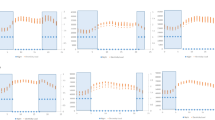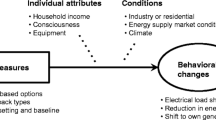Abstract
Daylight savings time was adopted for the purposes of reducing energy consumption, but recent studies have cast some doubt on whether it still serves this purpose effectively. This study estimates the effect of daylight savings time on electricity demand in Ontario, Canada. It uses a quasi-experimental approach, by leveraging the fact that the transition to DST occurs on a different day in each year. The results suggest that daylight savings time reduces the demand for electricity by about 1.5% in Ontario. The reductions in electricity consumption is concentrated during the evening period. The reduction in electricity demand appears to persist for at least several weeks following the transition to daylight savings time.









Similar content being viewed by others
Notes
Kellogg and Wolff (2008) provide some evidence that the simulation approach does not provide credible estimates of the impact of DST.
Sunset and sunrise times correspond to the city of Toronto, where economic activity (and electricity demand) in the province of Ontario is concentrated.
Rather than using a running index of dummy variables from 1 to 365 days of the year, I use the same number of dummy variables corresponding to each unique month-day pair. This picks up any effects that occur on particular days (e.g., November 11th is remembrance day in Canada, and although this is not a statutory holiday, electricity consumption could be affected).
Heating degree hours are defined as the number of degrees below 18 \(^\circ \)C for each hour, and cooling degree hours are the number of hours above 18 \(^\circ \)C for each hour. I also include the square of cooling degree hours, heating degree hours, and fraction of sunlit minutes. In a robustness test reported later in the paper, I examine alternative ways to incorporate the effect of temperature on electricity demand.
There are several very small communities in Northwestern Ontario that do not observe daylight savings time. I ignore these. Because they are very small, they should not impact the results, but any bias from including these communities will cause the estimates of the effect of DST to be attenuated towards zero.
The data is available at www.ieso.ca.
The IESO refers to this as ‘Ontario electricity demand’.
The data is available at http://climate.weather.gc.ca/.
I obtain nearly identical results when I include year–month fixed effects (i.e., a dummy variable for each unique year–month combination in the data).
I use the approach corresponding to the fourth column of Table 2, which includes hourOfDayOfYear fixed effects as well as interactions of weather variables with hour of the day to produce the figure.
Throughout the paper, the hour variable is the clock hour (i.e., with DST), and when a specific hour is referenced, it is the hour ending at that time (e.g., 8 p.m. is the hour from 7:01 p.m. to 8:00 p.m.). In contrast, the IESO does not adopt DST in reporting electricity consumption.
The bandwidth for the RDD approach is based on the approach to optimal bandwidth selection described in Calonico et al. (2014) and implemented in the R statistical package by Calonico et al. (2015). Results are robust to estimation with an alternative bandwidth selection based on Imbens and Kalyanaraman (2011).
The HOEP occasionally goes negative when demand is low and a significant amount of wind generation occurs. As a result, I estimate the model in levels rather than logs.
These are reported in Table 9 in “Appendix 1”.
References
Angrist JD, Pischke J-S (2008) Mostly harmless econometrics an empiricist’s companion. Princeton University Press, Princeton
Aries MBC, Newsham GR (2008) Effect of daylight saving time on lighting energy use: a literature review. Energy Policy 36(6):1858–1866
Belzer DB, Hadley SW, Chin S-M (2008) Impact of extended daylight saving time on national energy consumption. Technical report, US Department of Energy Office of Energy Efficiency and Renewable Energy
Biavati G (2014) RAtmosphere: Standard Atmospheric profiles. R package version 1.1
Calonico S, Cattaneo MD, Titiunik R (2014) Robust nonparametric confidence intervals for regression-discontinuity designs. Econometrica 82(6):2295–2326
Calonico S, Cattaneo MD, Titiunik R (2015) rdrobust: an R package for robust nonparametric inference in regression-discontinuity designs. R J 7(1):38–51
Christopher M B, Wagner DT (2009) Changing to daylight saving time cuts into sleep and increases workplace injuries. J Appl Psychol 94(5):1305
Doleac JL, Sanders NJ (2015) Under the cover of darkness: how ambient light influences criminal activity. Rev Econ Stat 97(5):1093–1103
Ebersole N, Rubin D, Hannan W, Darling E, Frenkel L, Prerau D, Schaeffer K (1974) The year-round daylight saving time study, vol I. Interim report on the operation and effects of year-round daylight saving time. Technical report, US Department of Transportation
Filliben JJ (1976) Review and technical evaluation of the DOT daylight saving time study. Technical report, US National Bureau of Standards Internal Report Prepared for the Chairman of the Subcommittee on Transportation and Commerce, Committee on Interstate and Foreign Commerce, US House of Representatives
Gelman A, Imbens G (2014) Why high-order polynomials should not be used in regression discontinuity designs. Technical report, National Bureau of Economic Research
Government of Ontario (2014) Achieving balance: Ontario’s long-term energy plan. Technical report
Imbens G, Kalyanaraman K (2011) Optimal bandwidth choice for the regression discontinuity estimator. Rev Econ Stud 79(3):933–959
Janszky I, Ahnve S, Ljung R, Mukamal KJ, Gautam S, Wallentin L, Stenestrand U (2012) Daylight saving time shifts and incidence of acute myocardial infarction—Swedish Register of Information and Knowledge About Swedish Heart Intensive Care Admissions (RIKS-HIA). Sleep Med 13(3):237–242
Kamstra MJ, Kramer LA, Levi MD (2000) Losing sleep at the market: the daylight saving anoma. Am Econ Rev 90(4):1005–1011
Kandel A, Metz D (2001) Effects of daylight saving time on california electricity use: staff report. Technical report, California Energy Commission
Kandel A, Sheridan M (2007) The effect of early daylight saving time on California electricity consumption: a statistical analysis: staff report. Technical report, California Energy Commission
Kantermann T, Juda M, Merrow M, Roenneberg T (2007) The human circadian clock’s seasonal adjustment is disrupted by daylight saving time. Curr Biol 17(22):1996–2000
Kellogg R, Wolff H (2008) Daylight time and energy: evidence from an Australian experiment. J Environ Econ Manag 56(3):207–220
Kotchen MJ, Grant LE (2011) Does daylight saving time save energy? Evidence from a natural experiment in Indiana. Rev Econ Stat 93(4):1172–1185
Kountouris Y, Remoundou K (2014) About time: daylight saving time transition and individual well-being. Econ Lett 122(1):100–103
Kuehnle D, Wunder C (2014) Using the life satisfaction approach to value daylight savings time transitions: evidence from Britain and Germany. J Happiness Stud 17:1–31
Lahti TA, Lönnqvist JHJ, Partonen T (2008) Daylight saving time transitions and hospital treatments due to accidents or manic episodes. BMC Public Health 8(1):74
Mirza FM, Bergland O (2011) The impact of daylight saving time on electricity consumption: evidence from southern Norway and Sweden. Energy Policy 39(6):3558–3571
Rock BA (1997) Impact of daylight saving time on residential energy consumption and cost. Energy Build 25(1):63–68
Smith AC (2016) Spring forward at your own risk: daylight saving time and fatal vehicle crashes. Am Econ J Appl Econ 8(2):65–91
Sood N, Ghosh A (2007) The short and long run effects of daylight saving time on fatal automobile crashes. BE J Econ Anal Policy 7(1):1–22
Teets DA (2003) Predicting sunrise and sunset times. Coll Math J 34(4):317–321
Author information
Authors and Affiliations
Corresponding author
Appendices
Appendix 1: Additional Results
See Figs. 10, 11, 12, 13 and 14 and Tables 5, 6, 7, 8 and 9.
Non-linear effect of temperature on hourly Ontario electricity demand. Points in the figure are regression coefficients reflecting the effect of temperature in a given bin on Ontario electricity demand. All coefficients are the effect on demand relative to an hour in the (17.8, 18.4 \(^\circ \)C) temperature bin. 95% confidence intervals are given as gray lines
Placebo regression discontinuity estimate for effect of DST on log electricity consumption. The left hand panel corresponds to the placebo spring DST transition and the right hand panel corresponds to the placebo fall DST transition. In each case, the figures include only data from within 30 days of the DST transition. The data used consists of hourly Ontario electricity demand from 2002 to 2014. Placebo DST transitions are constructed by applying the DST transition rule for 2007–2014 in the period 2002–2006 and by applying the DST transition rule for 2002–2006 in the period 2007–2014
Regression discontinuity plots of temperature and sunlight. The left hand panel reports residual temperature (after demeaning with the same fixed effects used in the main RDD specification) for different values of the running variable. The right hand panel reports the residual sunlight, where sunlight is reported as the share of minutes in each hour where the sun is above the horizon. Local linear regressions are superimposed on residual temperature and sunlight
Appendix 2: Weather Data
This section details the construction of a provincial hourly temperature data set, which is used to test the robustness of the results to an alternative specification of the weather variables. I obtain temperature measurements from all Environment Canada weather stations in Ontario (i) that record hourly temperature and (ii) that are in operation starting at or before 2002 and in operation to at least 2014, which spans the electricity consumption data. There are 55 weather stations that meet these criteria. Data is available at the Environment Canada website (www.climate.weather.gc.ca). For each of these weather stations, I obtain hourly temperatures for every hour from January 1, 2002 to December 31, 2014. A map of the weather stations I use in the analysis overlaid on the population density of Ontario is given in Fig. 14. Both population and weather stations are highly concentrated in the Southwest of the province, around the city of Toronto.
To construct a provincial average hourly temperature, I weight weather stations according to population. This proceeds in three steps:
-
1.
I obtain data from the 2011 population Census on total population, grouped by forward sortation area (FSA). There are 516 forward sortation areas in the province of Ontario. For each FSA, I determine the latitude and longitude of the centroid. I then find all weather stations that are located within 300 km of the FSA centroid (a large area is required because some sparsely-populated FSAs in Northern Ontario are far from weather stations). For each FSA, I assign a weight for all weather stations within 300 km by calculating the inverse of the distance from the weather station to the FSA centroid.
-
2.
I construct an estimate of the hourly weather in each FSA using a weighted average of the recorded temperature in each monitoring station that is within 300 km of the FSA centroid. For stations with missing hourly temperature observations, I drop the station for the hours in which data is missing, and estimate the FSA temperature using data from remaining stations.
-
3.
I construct a provincially-weighted average temperature by weighting the temperature measure from each of the 516 FSAs by their 2011 population.
Using the provincially-averaged temperature measure, I repeat the analysis used to produce Table 2. These are given in Table 10. All coefficients retain the same sign and significance as in the main analysis. The coefficients using the provincial temperature measure are slightly smaller than the main results in the text, but are statistically identical. The most saturated model suggests that DST adoption reduces daily average electricity consumption by 1.4% when using the provincial temperature measure, compared to 1.5% when using the Toronto monitoring station only.
Rights and permissions
About this article
Cite this article
Rivers, N. Does Daylight Savings Time Save Energy? Evidence from Ontario. Environ Resource Econ 70, 517–543 (2018). https://doi.org/10.1007/s10640-017-0131-x
Accepted:
Published:
Issue Date:
DOI: https://doi.org/10.1007/s10640-017-0131-x









